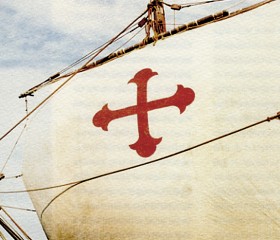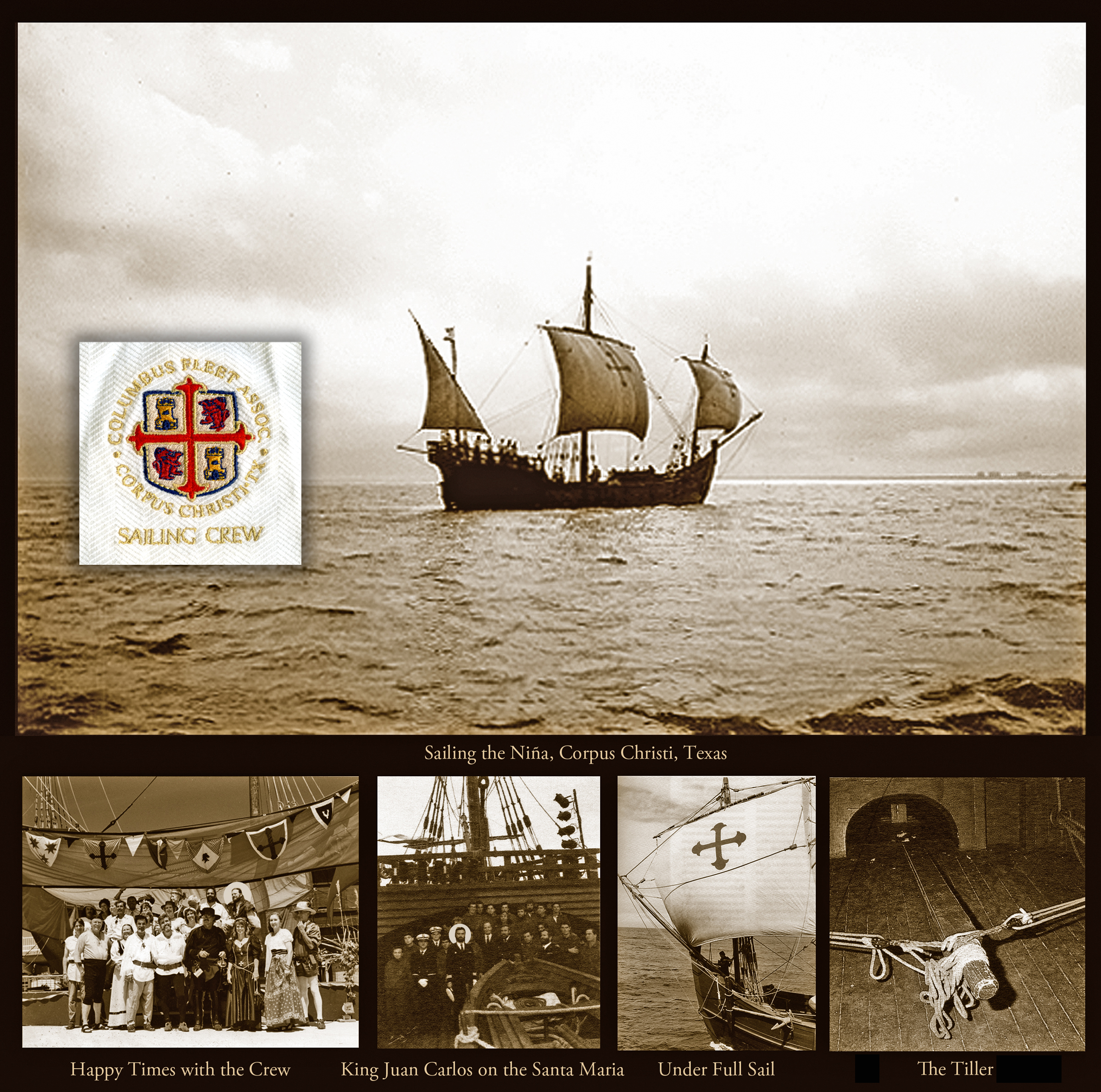I was drawn to the Columbus Fleet ships that had sailed to the United States in 1992, on the 500th anniversary of Columbus’ first crossing. I became one of the American Crew of the ships while they were harbored in Corpus Christi, Texas. José Antonio, First Mate of the Santa Maria, remained behind to create a 15th Century sailing school, whereby one could learn to work, maintain, and sail these magnificent ships.
The ships were a feast for the senses. The sea water brought out the archaic mix of scents of wood, hemp, and canvas, and the coastal sun baked the sealing linseed oil and tar to an aromatic, dark amber. With the raising of the yards, great wood bearings called parrells creaked as they rolled over massive wooden masts, carved from a single tree. It would take eight men to haul the main sail up, together to the chant of “Two, Six, Heave…!” Hemp lines barked, snapped by canvas sails, moaning at the pin rail and yard arms, to a peal of block and tackle as the yards turned to change tack.
Ships of that era had a 10 year life span and because these were constructed exactingly from trees cut from the same forests as the original ships, they required a lot of expert maintenance. Some in Spain believed that there would not be enough shipwrights left with the knowledge and skills to recreate the ships again in this century. There never were drawn plans back in the day. A shipwright passed information down to an apprentice hand to hand, and many details today are still gleaned from shipwrecks of that era or paintings that survive.
The crew were among the most lively and engaging people I have ever known. They lived to the fullest every day. And they came from all walks of life; nautical archeologists, artists, teachers, naval officers, sailors, architects, historians. Given the troubled nature of the crew from the original crossing in 1492 (many were indentured criminals), there couldn’t have been a better group of emissaries for healing and good will. The ships were living museums where children and adults alike could experience the sights and sounds of them at dock and under sail. The ships were decorated with Christmas lights and sailed during the holidays. The crew’s long term goal was to sail into New York harbor, leading the parade of tall ships in 2000, to welcome in the new Millennium.
Jerry was one of these hail fellows well met. I had never sailed a boat before. With his help, I finished the course and later became one of the Assistant Instructor Staff.
Retired now, Jerry lived on a boat beneath the JFK bridge. He had been a bush pilot in Alaska for years, then left it all to sail solo to Bora Bora in the middle of the Pacific Ocean. He had invited me to join him in a few months when he would leave the US for Belize, where he would work as a dive instructor.
I anguished over the invitation for months. I had a job with a lot of responsibility, I was in a long term relationship, I had debts and obligations. It just didn’t seem to be in the cards. But something was calling me to go and I thought about it every day.
After a day of sailing the Niña, on the way to one of the crew’s beach bon-fires on Padre Island, while crossing the JFK bridge, the hood on Jerry’s jeep came unlatched and swung up and struck him on the head. Jerry was a tough old bird. He was dazed but clear enough to finish driving to the beach with the rest of us. Despite a rising bump, he seemed unfazed and as cheerful as ever.
That day I had manned the tiller on our sail. You would stand on it sideways, steering the ship with the strength of your legs, with your head peering out of the Pope deck, right behind where the captain stands. Feeling that ship respond under sail was exhilarating. My confidence was up and I had at last decided to join him on his exodus to Belize. I told Jerry that the next day I would give my notice at my job.
We were to leave in two weeks and my life would change forever.
When the time came for me to talk to my boss, there was another person in his office and I decided I could wait until tomorrow to have the conversation. On arriving home, shortly afterward I received a phone call. A friend from the crew called to tell me Jerry had died that day in 40 feet of water, getting his Dive Master certification.
Although very humble, Jerry was a great man. He was a tough old salt, self-reliant yet still approachable. He was a good friend to me when I struggled with the aftermath of a near-drowning incident months earlier. I struggled with the swim test, and those dastardly knots! He saw clearly my internal struggles with confidence; that skills could be learned, but confidence comes from within. He reached out to me and pulled me through.
We held a service for Jerry on the Niña, and played a farewell with a fife and guitar beneath the main sail. It was a sweet tune, “Jerry’s Jig”, written for him by Kim, one of the crew and a floutist with the Corpus Christi symphony. A wave of white roses floated out for him on the tide.
I realized later, after the shock of his death wore off, that perhaps I had only to decide that I could go to Belize. That I only had to embrace the possibilities of the dream, and believe in myself and trust in another. Jerry made that possible.
For an essay written for the Fleet’s publication “Signals” I adapted the famous haiku by Issa about the pheasant and the mountain to reflect my awakening experience with the fleet ––
the cormorant cries / as if it has / just noticed the sea
Jerry opened me to the power of the dream. He had indeed changed my life forever, and made great days possible with the Fleet and its wonderful crew.
Through the faith of him and others I rediscovered the power within myself, as if I had just noticed the sea.
¡Salúd!





